Exhibition texts
Indigo Waves and Other Stories: Re-Navigating the Afrasian Sea and Notions of Diaspora
Introduction
The research and multi-chapter exhibition Indigo Waves and Other Stories sheded light on the historical, cultural and linguistic links between the African and Asian continents, as seen through the work of contemporary artists, filmmakers, musicians, writers and thinkers. The exhibition chapters at Gropius Bau and SAVVY Contemporary have been composed in resonance. While moving between these venues, visitors were invited to experience fluid associations that opened up like the tug and swell of tides.
Indigo Waves and Other Stories responded to a need to rethink the histories and processes of dispersion, and to reconsider notions of diaspora and cultural belonging. Here, the Indian Ocean served as a communal horizon from which to read Afrasian histories of the forced and unforced movements that occurred historically through currents of coastal societies, water-borne kinship and mercantile imperialism. The project’s perspective was one of perpetual hybridity – addressing what Françoise Vergès calls “the politics of forgetfulness”, rather than recentering the colonial gaze and restoring asymmetries of power while echoing from the annals of bygone exploits.
Ziwa Kuu, the Swahili Sea, the Afrasian Sea, the Indian Ocean, Ratnakara, Eastern Ocean, Indic Ocean or Bahari Hindi are just a few of the plethora of names used to characterise a body of water, making up a fifth of the earth’s oceans, and which has been dubbed the oldest continuum in human history. It spreads between the East African coast, bordering Asia on the north, engulfing Australia in the east and stretching south to the Southern Ocean.
Yvonne Adhiambo Owuor
In Yvonne Adhiambo Owuor’s The Dragonfly Sea, the novel’s Kenyan and Indonesian subjects, Ari and Ayanna, give many names to this ocean. There may be much in a name, but no single name can encompass, contain or express all that this body of water stands for, tells, sings and invokes. It is too complex, too deep, too vast and pregnant with a plenitude of histories to carry just one name. What is certain is that rather than divide, it connects geographies, cultures, peoples, languages, foods, sounds, winds, waters, economies, philosophies and more. The ocean is a fluid joint: a junction of and for affinities and realignments prior to nation-state allegiances.
Nikhil Chopra
In charting the free-flowing nature of Afrasian waters, we acknowledge how the navigation and inhabitation of the Indian Ocean has been historically premised on seasonal cycles and wind systems. In One Water, Many Lands (2023) Nikhil Chopra evokes the contours of water cycles that interlink the Indian Ocean with the lands it unfurls against. Throughout much of his work, Chopra’s performative acts are strongly connected to egress and landscape. This is done as a means to channel a personal metamorphosis, but also with the aim of transforming physical and mental spaces. Here, journeying through a vast marine scenery is a way for Chopra to trade the stability of the land in exchange for a liquid horizon in perpetual states of motion – from glaciers to waterfalls, estuaries to clouds. Incarnating a humble persona dressed in mud and cotton, he dwells on a floating platform, painting waterscapes on canvas sheets with deep blue pigments and ochres obtained from mud and clay. With a twelve-hour performance and a room-scale installation, Chopra’s body acts as a catalyst, transfiguring the architecture of the Gropius Bau with representations of the sea, celebrating the oneness of water, the connectedness of its ecologies and its fluctuating cycles.
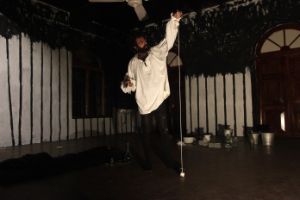
The Black Pearl: Aspenwall House, Kochi-Muziris Biennale, 2014, Costume: Loise Braganza
Courtesy: the artist, photo: Shivani Gupta
Shiraz Bayjoo
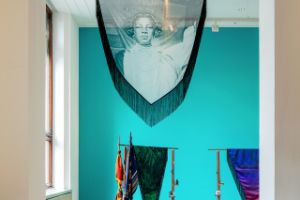
Indigo Waves and Other Stories: Re-Navigating the Afrasian Sea and Notions of Diaspora, Shiraz Bayjoo, Installation view, Gropius Bau (2023)
photo: Luca Girardini
Shiraz Bayjoo creates talismans that carry the weight of mourning and survival, recollecting foremothers and their struggles in the Indian Ocean world – particularly from the shorelines of Mauritius, Madagascar and most recently from research in South Africa. Bayjoo listens for buried archives that often lie far beyond the museum, traversing graveyards, ruins, literary texts, court records and botanical gardens. To borrow a term from poet and thinker Kamau Brathwaite, his pursuit carries on the “tidalectics” of remembrance, bearing witness to creole formations and notations of marronage – recalling those in the Indian Ocean’s islands and the Americas who escaped slave societies and formed their own independent communities and settlements. His sculptures include photographs as well as textile flags using Shewshew batik and Kanga fabric. The images include archive portraits of Malagasy queens, coastlines of early Dutch arrival in Mauritius and Indigenous as well as transplanted fauna. Composed as wooden display systems that investigate museological approaches but also gesture toward shrines and altar pieces, Bayjoo notes, “[t]hese works draw lines of enquiry between ‘Land erasure’ and matriarchy and a way of survival within the plantation landscape.” The installation Lamer Vide, Later Ruz (2022) also links ancestral traumas and defiant wayfinding in dialogue with storyteller Traci Kwaai, who has been exploring her familial narratives in Kalk Bay, a historic fishing village in greater Cape Town, and charting traditions of generations of fishing communities in the Cape.
Clara Jo
Islands and archipelagos of this ocean have included some of the earliest architectures of quarantine and colonial hospitals that have induced traumatic suffering. The movement of human beings has been accompanied with animals and botanicals along ancient maritime routes. The history of epidemics is often recounted through a colonial lens and thus framed problematic terms for contagion, such as “exposure” and “first contact” that continue to reside and shape societal notions of a healthy subject. Clara Jo conceives a film with animation sequences that invite us to critically reassess the nautical imagination and the docking on land through processes of decay, the circulation of contagious disease, detention and regeneration. The artist reflects on historical antecedents of incarceration in Albion and Flat Island in Mauritius and presents allegorical protagonists to explore how fear is planted in our living systems: how viral loads and waterborne diseases have spread with mercantile ambition and, finally, which bodies are pinned down as “foreign agents” and thus stigmatised as threats to the civic body.
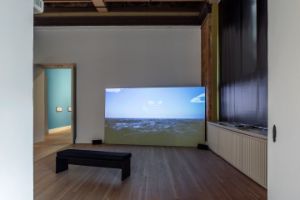
Indigo Waves and Other Stories: Re-Navigating the Afrasian Sea and Notions of Diaspora, Clara Jo, Installation view, Gropius Bau (2023)
photo: Luca Girardini
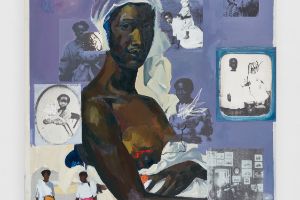
Kudzanai-Violet Hwami und Belinda Zhawi, Buktu, Anna, Nehanda, 2021
© Kudzanai-Violet Hwami and Belinda Zhawi, courtesy: the artists and Victoria Miro
Kudzanai-Violet Hwami und Belinda Zhawi
Kudzanai-Violet Hwami and Belinda Zhawi’s painting and sonic installation Black Anna (2021) looks to the question of domestic labour. Enslavement labour, indentured labour, underpaid labour and care work of varying kinds are part and parcel of the histories of forced migration across the Afrasiatic Sea as well as the Atlantic Ocean. In many cases women are especially susceptible to the most exploitative conditions of labour. The installation takes its cue from the story of Zwarte Anna (Black Anna), a black [enslaved] woman from Suriname who arrived in Arnhem in 1727, accompanying the family she worked for. The work imagines narratives around Black Anna beyond the servant, departing from the private world(s) she might have created for herself, her person, but also depicting her in moments of rest, reflection and aloneness. A presence for Anna is thereby created beyond her labour. Simultaneously, Hwami introduces Paula, a present-day Black Anna, uprooted from her country of origin, working as a servant for a European family. Now the artist wonders who Paula is to this family outside of her labour, outside of being “the help”? Hwami invites the viewer to see Black women’s personhood for what it is: a rich existence beyond the scripts of life that were and still are placed upon them.
Jennifer Tee
Trade textiles, such as East African Kanga, Pelangi in Southern Sumatra and Indian Chintz, reveal embodied legacies and centuries old circuits of oceanic exchange. Jennifer Tee reconnects with her Chinese-Indonesian ancestry by journeying to Sumatra and studying textile collections in Europe. Her encounter with tampan and palepai textiles, known as ship cloths by Europeans, has led to a longer-term inquiry. Reviving emblematic patterns through a collaging process using pressed tulip petals, the artist pays homage to an ancestral crossroads between her father, who travelled by ship with his sister and parents to the Netherlands after the Second World War, and her grandfather, an exporter of tulip bulbs, who frequently sailed to the United States. With Tee’s artistic corpus Tampan Tulip, which she has grown since 2010, the ship becomes a site of transfiguration that resonates as cultural leitmotif and structuring principle, reframing its role in littoral societies beyond maritime power. As tampans reveal, there is an intrinsic correlation between the boatload and the household as social units indicative of both the container and the contained. Often represented around the ship and its interior are amphibians, birds (such as hornbills), snakes and the tree of life. As ceremonial textiles, the illustrations carried within also connect to the divine sphere.
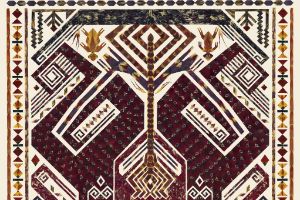
Jennifer Tee, Tampan Sessile Beings, Sacred Shrine, 2022
courtesy: the artist and Galerie Fons Welters, Amsterdam
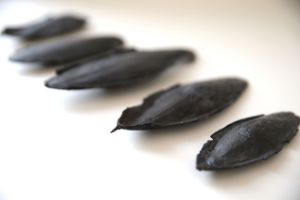
Jeewi Lee, Encounter (Future Past Tense), 2023
© Studio Jeewi Lee
Jeewi Lee
In Encounter (Future Past Tense) (2023) von Jeewi Lee stehen Sepiaschalen als Metapher für Zerbrechlichkeit und Tapferkeit. Sie sind federleicht und lassen sich leicht eindrücken und zerkratzen, sind aber gleichzeitig robust genug, um der Rauheit des Meeres zu trotzen. Die Mikrostruktur des Knochengewebes verleiht den Sepiaschalen Festigkeit und Widerstandsfähigkeit gegen Beschädigungen. Diese Knochengewebe bestehen aus winzigen vertikalen Säulen, die es dem Tintenfisch ermöglichen, sie als Kammern zur Auftriebskontrolle zu nutzen: ein Organ, das im Wasser atmet. Jeder Knochen, der nach einer langen Reise durch den Ozean an Land gespült wird, ist ein Träger verkörperter Erinnerungen, die in Rillen und Spuren auf seiner spröden und filigranen Oberfläche eingeschrieben sind. In Lees spekulativer Untersuchung rührt der symbolische Wert dieser Objekte von Begegnungen her, die während einer Recherche im Senegal am Strand stattfanden, einer porösen aquatischen Grenze, die ozeanische Erinnerungen bündelt. Von dort aus zeichnet Lee, wie beim Aufbau eines Archivs, den Abdruck der Knochen auf Hanji-Papier auf und versiegelt jeden einzelnen mit einer schützenden metallischen Glasur. Die mit Kupfer überzogene Sammlung von Spuren auf über fünfhundert Sepiaschalen bildet eine Anthologie von Geschichten, die zwischen der irdischen und der ozeanischen Welt schweben.
M'barek Bouhchichi
M’barek Bouhchichi’s sculptural work superimposes the concepts of a braille slab and a tribulum. A tribulum is a historical sledge for threshing still used in many parts of the African continent to separate seeds from the lot of a harvest as well as chaffs. This broad, heavy mostly wooden board is furnished with teeth of stone or iron and visually reminiscent of writing systems on stones in varying civilisations around the world. This connection to writing inspired Bouhchichi to deliberate on the many writings that connect North Africa in general and Morocco in particular to the Indian Ocean and the lands beyond the eastern shores of that body of water. Even if some of these writings and traces are erased from the view of some, they still exist in other forms and can be read otherwise. Bouhchichi appropriates the braille system as a metaphor for that which is written otherwise. The texts in braille are excerpts from travel accounts of the renowned Amazigh-Moroccan traveller Abū ʿAbdallāh Muhammad ibn Battūta (1304–1368/1377) who is said to have travelled most of southern Europe and crossed the Afrasiatic Sea to Asia. These travels are dictated in his travelogue A Gift to Those Who Contemplate the Wonders of Cities and the Marvels of Travelling (The Rihla), as well as text excerpts by another Amazigh-Moroccan Muslim scholar, Abu Al-Barakat Yusuf Al-Barbari, who is thought to have brought Islam to the Maldives.
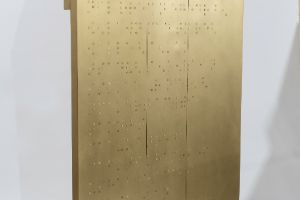
M'barek Bouhchichi, Essential words I, 2022
Courtesy: the artist
Jasmine Nilani Joseph
Often beginning with field research around the Jaffna peninsula as well as conversations with neighbours and local groups, Jasmine Nilani Joseph’s series of drawings dwell on private and public memory. She focuses on security structures and the pervasive militarisation of the domestic sphere and the natural world. The artist’s biography plays out in several of her works, which include accounts of fleeing violence and forced displacement during childhood through the years of civil war. In plotting architectural motifs and the built environment interweaving rural coastal zones, the artist conveys embedded complexities of exodus and resettlement, language barriers and cultural loss. Unveiled Barriers (2019) reflects on the ocean’s role as a mediator of pathways within and out of Sri Lanka. Joseph charts miniscule details of shelters built by fishing communities, the Indian coast guard intercepting small boats and detention camps built by the Australian government that continue to threaten the lives of those fleeing from this coastline. In her new works, The Cursed Journey (2023) and In the Shades of Builders (2023) she interweaves the port cities of Old Goa and Fort Kochi, following her travels. She charts alleys that have historically hosted spice trading in Mattancherry, Kappiri shrines dedicated to deceased Africans, the coral walls of Jaffna fort and a former Dutch hospital at Neduntheevu (Delft island) in the Palk Strait. Joseph’s drawings reflect on the ways natural boundaries and coastal frontiers act as spaces of affiliation, while also remaining hazardous amidst the repressive clutches of ethnic divides in a bounded island geography.
Kelani Abass
Kelani Abass proposes an installation comprising Casing History, The Root Across the Walking Path, 1,2,3 (2022) and The root across the walking path (2022). The former is a sequel in his long-term research project of searching through archives. Abass’s mixed-media assemblages are made up of letterpress type-cases, historical photographs and handwritten notes from family archives that date back as far as the 1920s. One of his many points of departure is his family’s printing press and the way this medium of capturing information, stories, knowledges and histories ties together the familial (the micro) to the societal (the macro). Abass’s installation The root across the walking path considers water as a carrier of shared and individual histories and a player in the ecosystem of things, cultures, environments, bodies, travel, food and medicine. It is a reflection of water as an intrinsic part of people’s identities, cultural perceptions, religious beliefs and worldviews. Water is a relevant and significant variable that is also germane to the understanding of the Yoruba peoples’ identity, culture and religion. Abass states that “through images, text and intricate relationship with memory, my project will take its root from a family journal written in Yoruba, which dates as far back as 70 years of my family existence with recordings of events, child births, deaths, traditional invocations, evocation of powers, orthodox prescriptions, love potion recipes and autobiographies.”
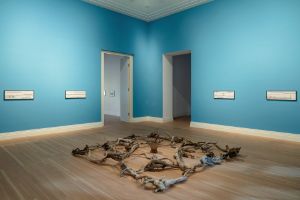
Indigo Waves and Other Stories: Re-Navigating the Afrasian Sea and Notions of Diaspora, Kelani Abass, Jasmine Nilani Joseph, Installation view, Gropius Bau (2023)
photo: Luca Girardini
Dhow Countries Music Academy
Dhow Countries Music Academy is invited to compose and conjure a sonic scape of the Afrasiatic Sea. Perhaps the most appropriate way to navigate that body of water is to use music in particular and sound in general as the compass. As a music school in Zanzibar which preserves and promotes musical heritage of the “dhow region” (including countries along the shores of the Indian Ocean and the Arab Gulf such as Zanzibar, Comorros, Oman, Kuwait, Iran, U.A.E and India), the members of the Dhow Countries Music Academy have their ears not only proverbially on the ground, but also under water. As an institution, the Dhow Countries Music Academy is also tasked with teaching traditional music from the “dhow region”, such as taarab, kidumbak and ngoma, thereby serving as guardians of a living cultural heritage. The academy’s name alludes to the traditional sailing vessels, the dhow, used over centu-ries to cross the sea from and to the East African coast to the Arabian Peninsula and the West coast of Asia.
John Njenga Karugia
The scholar Engseng Ho addresses creole kinship in his writing on the Hadrami diaspora and the distribution of inheritance as non-linear. These aspects also gain visibility in the long-term research journeys of John Njenga Karugia that emphasise on tributaries of memory cultures, aural inheritances and material legacies of sea-faring communities intercrossing between Kenya, Oman and Indonesia for centuries. His anecdotal archive of photographs and the documentary film Afrasian Memories in East Africa (2018) are on view, offering glimpses of what lies behind-the-scenes of scholarship, private contestations and coastal imaginings that might comprise the marginalia of what academia (re-)claims or rejects as part of “Ocean Studies”.
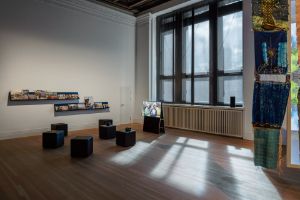
Indigo Waves and Other Stories: Re-Navigating the Afrasian Sea and Notions of Diaspora, John Njenga Karugia, Installation view, Gropius Bau (2023)
photo: Luca Girardini
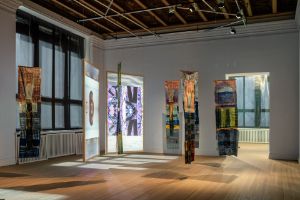
Indigo Waves and Other Stories: Re-Navigating the Afrasian Sea and Notions of Diaspora, Adama Delphine Fawundu, Installation view, Gropius Bau (2023)
photo: Luca Girardini
Adama Delphine Fawundu
Sea deities, djinns and aquatic spirits such as Mami Wata are recurring vivid and powerful entities in the hydro-imaginaries of Africa and the African atlantic. Adama Delphine Fawundu delves into this sphere of ancestral and sacred time-keeping in her video and sculptural works, braiding the protective and fearsome qualities of multi-spirited and creolised waters. Through exploring her familial stories from her Sierra Leonean heritage, her Mende ancestors, and inspired by Senegalese Baye Fall culture in Hymns and Parables (2022), the artist uses indigo dyed and batik fabrics, cotton paper from India and Brazilian banana paper, frankincense and cowrie shells. Drawing from her grandmother’s textiles and new patterns printed as cyanotypes and using UV-activated inks, she describes these series as “codes”. In this way, audio-visual recordings and human-scale layered pieces perform as tessellated realms of cosmological relation-making, masquerade and larger diaspora chronicles. Fawundu’s practice has long recognised water’s elemental role in ceremonies for cleansing and sacrifice, marking the lifecycle from birth to death.
Rossella Biscotti
Transnational mobilities and immobilities in the oceanic sphere are shaped to a large degree through labour networks and plantation societies. Arunima Datta considers women’s migration experiences in colonial Malaya that extend a nuanced understanding of the lives of indentured Indian “coolie” women, problematising the stigmas and moralistic codes that accompanied imperial accounts. Thereby, providing a subjective view into how the South-East Asian archipelago’s gendered histories contributed to the empire of rubber. Rossella Biscotti commits to circulating biographical, botanical and literary encounters around banned and forgotten histories through her artistic work. In her “rubber works” – Annalies, Mei, Princess of Kasiruta, Sanikem - Nyai Ontosoroh - Madame Le Boucq, Surati (2019) she focuses on the four-volume novel The Buru Quartet (published gradually between 1980–1988) by acclaimed Indonesian author Pramoedya Ananta Toer, first expressed orally when the author was under detention in a camp on Buru island. Biscotti’s installation is inspired by five of its characters, one of which is based on the life of Surati, who contracts smallpox voluntarily in her efforts to escape subjection as a concubine under Dutch colonialism. In gleaning subjectivity from fragmented records, Biscotti weaves a lineage of feminist agency, ecological entanglements and potential affiliation. The use of Batik textile patterning upon translucent natural resin acts as a bodily imprint, recalling shared memory as well as rebellious, transient and disappearing voices.
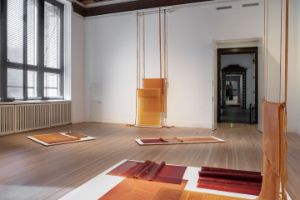
Indigo Waves and Other Stories: Re-Navigating the Afrasian Sea and Notions of Diaspora, Rossella Biscotti, Installation view, Gropius Bau (2023)
photo: Luca Girardini

Indigo Waves and Other Stories: Re-Navigating the Afrasian Sea and Notions of Diaspora, Rossella Biscotti, Jack Beng-Thi, Sim Chi Yin, Installation view, Gropius Bau (2023)
photo: Luca Girardini
Jack Beng-Thi
From Réunion Island, Jack Beng-Thi has travelled across the many islands and archipelagos of the Indian Ocean world. These creative voyages have resulted in public artworks and the dissemination of poetry, performance and experimental pedagogy. It has also been an endeavour in attesting to and carrying forward the multiple ancestries held within him, including his Indian, Chinese-Vietnamese, African and European lineage. Beng-Thi commemorates the enslaved body, narratives of displacement and coerced movement through maritime imperialism. He also celebrates water-borne kinship amidst islander communities using materials such as terracotta, plant fibre and volcanic stones to gesture to organic histories and sacred geography. Through his decades of practice, the ocean is addressed as a common ancestor that dissolves centre and periphery, instead drawing closer Afroasian and Austronesian literary cultures and sediments of human violence. His installation assembles book sculptures that recognise Africanity across Madagascar, Mauritius, Comoros, Réunion and Mozambique.
Malala Andrialavidrazana
Malala Andrialavidrazana’s series of photomontages titled Figures (2015–ongoing) is a deep reflection on the problematics of cartography and the violence and finiteness of maps. As Lee Maracle aptly puts it in her poem Maps: “Maps are pretentious arrogantly purporting to know where everything is. Pretending power where none is. Maps are finite. Maps are always old.” Figures reads like an exhumation and recomposition of pictorial, symbolic and representational legacies. It brings together historical personalities alongside the faces of ordinary men and women whose roles, conditions and destinies have been overlooked across times and geographies. Fascinating both for their historical heft and their absurdities, they inform about political deviation, intellectual manipulation, systems of privilege and domination between genders, colours, classes or nations. It overlays the graphic reliefs of telegraphic cables, river systems and journeys of sacred philosophy with civilizational imagery of paradoxes and proximity. In Andrialavidrazana’s endeavour, one finds a path toward navigating collective truth and sovereign forms of place-making, echoing Kei Miller’s reflections in The Cartographer Tries to Map a Way to Zion:
to anticipate the ironic
question: how did we find
ourselves here? My job is
to untangle the tangled,
to unworry the concerned,
to guide you out from cul-de-sacs
into which you may have wrongly turned.
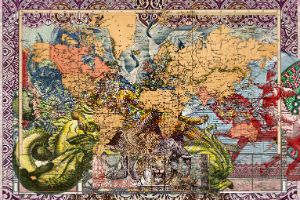
Malala Andrialavidrazana, Figures, 1853
© Malala Andrialavidrazana
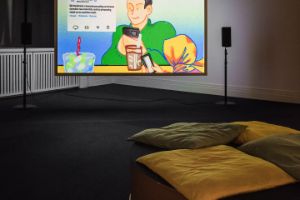
Indigo Waves and Other Stories: Re-Navigating the Afrasian Sea and Notions of Diaspora, Köken Ergun, Installation view, Gropius Bau (2023)
photo: Luca Girardini
Köken Ergun
“Invest in Indonesia / make sure that you don’t miss it!” goes the refrain of a song featured in Köken Ergun’s China, Beijing, I Love You! (2023). The newly-commissioned film is an animation that charts with documentary rigour the network of sea routes known as the Maritime Silk Road, which services the extractive economies of rare earths between Indonesia, China and the Democratic Republic of Congo. Essential to the production of EV batteries, mobile phones and missile technology, in the film Nickel and Cobalt are metals-turned-characters who face extraction and exile through Afrasian networks of profit and consumption. While a group of suited-up men tout investment as the way forward to national prosperity, the grievances of Nickel are echoed by the political unrest of workers in processing plants, who protest for better working conditions, environmental protection and health safeguards. Along with the plea of Nickel to be returned to the ground where she belongs, ecological depletion and health hazard are reminders that different forms of planetary cohesion are needed in the Indian Ocean world.
Sim Chi Yin
“The world is running out of sand. It seems counter-intuitive but sand, besides air and water, is our most used commodity”, reflects Sim Chi Yin. In the adjacent room, her photographic installation and VR narrative chronicles the movement and depletion of this non-renewable resource from Vietnam’s Mekong Delta and across Asia (in particular China, Malaysia and Singapore) through a desire for frenzied urbanisation, the development of new metropolitan areas and a constant drive for land reclamation that transforms coastlines. The transit of sand piles across rivers, into container ships and storage sites in construction areas, is often plotted by Sim through aerial imaging. This approach creates a different scalar and spatial perspective from which to comprehend mining and trading processes. The newly-produced work Garden of No Return (2023) weaves together lullabies and laments as well as poetry written and narrated by Vietnamese writer Khải Đơn to grapple with detrimental effects of landslides and large-scale erosion which destroys homes, livestock and ancestral shrines. Sim Chi Yin, together with Dan Archer, creates an experiential terrain that uses photogrammetry imagery and filmed sequences while also allowing for leaps into the poetic and uncanny to allude to communal losses and extreme precarity in the global business flows of sand mining.
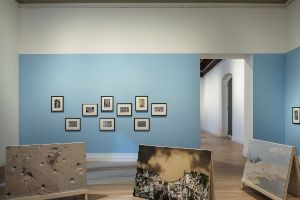
Indigo Waves and Other Stories: Re-Navigating the Afrasian Sea and Notions of Diaspora, Sim Chi Yin, Dominic Sansoni, Installation view, Gropius Bau (2023)
photo: Luca Girardini
Dominic Sansoni
Dominic Sansoni has been making photographs in the Maldives archipelago since the 1980s. His travels have extended to the smallest atolls chronicling vanishing ways of life, rural labour and traditional architecture that is held in stark contrast with luxurious resort culture. The presented series highlights coral stone mosques that are centuries old and convey the transoceanic legacy of Islam. In this monochromatic suite, coral stone carpentry which is considered unique to Maldives as a civilisation is brought into sharp relief, especially in close-up images of facades, raised platforms with calligraphic decorations and tombstones in mosque compounds. Given the environmental impact of coral mining, its use in tropical architecture in the Indian Ocean region has come to a halt. However, the built forms that are still standing convey close ties to coral architecture along the Swahili Coast and Sri Lanka. The spread of coral stone’s use in building structures extends from the Arabian Sea, Red Sea to the Central Pacific. Like these mosques, the historic boat building techniques in Maldives using coconut timber also reflect common techniques of boat making in East Africa.
Oscar Murillo
Oscar Murillo’s series surge (social cataracts) (2019–ongoing) invokes the aesthetics of Claude Monet’s paintings of water lilies to reflect on the plethora of signifiers that bodies of water connote. No matter how gentle some waters are, their undercurrents seem to tell other stories. Murillo’s social cataracts seem to unravel the stories told by the undercurrents. It is difficult to think of the bodies of water that connect the African continent to the rest of the world without bearing witness to traumas that lay underneath the swirling waves. As Amiri Baraka put it: “At the bottom of the Atlantic Ocean there’s a railroad made of human bones.” Murillo uses stitched-together patches of canvas, broad agitated strokes of blue, green, red, yellow paint to express the voices of the undercurrents. This suite also reminds us of the hydrological cycle and processes of weathering that connect rain clouds with the bottom of the sea. Although Murillo takes his cue for this series from the story of Monet’s suffering from cataracts when he painted the water lilies, the work itself invites us to think of the colonial enterprise as an impairment of vision that still throws a dense cloud over humanity — thus coloniality is a social cataract. With the enthralling beauty of these paintings, we are reminded that despite all the odds, waters still connect, waters transcend borders, disrespect maps and are the life-bearers of the planet. As Fela Kuti put it: “water no get enemy”.
“as if there is a path where beings truly meet, as if I am rounding the human corners”
— Linda Hogan, The Turtle Watchers (2008)
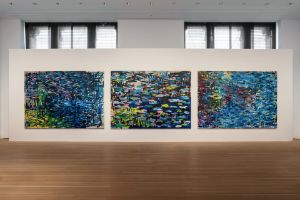
Indigo Waves and Other Stories: Re-Navigating the Afrasian Sea and Notions of Diaspora, Oscar Murillo, Installation view, Gropius Bau (2023)
photo: Luca Girardini
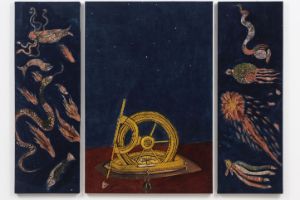
Lavanya Mani, Spectral Objects (From the Book of Wonders), 2019
photo: Anil Rane, courtesy: the artist and Chemould Prescott
Lavanya Mani
The textile paintings of Lavanya Mani mediate relations with the ocean via real and chimerical creatures, manifesting their claims for a better treatment of planetary commons. Evoking characters of the deep sea and skies, Spectral Objects (2018–2019) dives into obscure waters to contest the idea that human mastery through scientific instruments of navigation can assume supremacy over the seas. Dispelling the construction of “darkness” as a space of regression or anti-modernity, the sea’s depths echo with calls to rethink our place in the cosmos. Mani’s multispecies community unlocks layers of colonial and precolonial pasts, drawing from Persian miniatures and 16th Century German woodblock prints to reveal our symbiotic connectedness with the oceanic sphere. Similarly, The Ark (2018–2019) reminds us that the Ocean doesn’t dream of modernisation but rather demands to be cared for. Creatures of the land, sky and sea are enlarged and congregate on two sides of a pyramid-like assemblage, parodying anthropocentric cultures of ecological exploitation and apocalyptic extractivism through animal fables and allegorical imagery. The iconography, drawn from Miskin’s miniature paintings of the Mughal period and the biblical narrative of divine punishment opens paths to imagine hybrid encounters, recognising that water bodies are home to networks of solidarity among “beyond human” assemblies.
What does oceanic “Re-memory” look like? How does one correspond with and commemorate this terrain that is equally one of connection as of indenture and trauma? The ocean is a persistent form even as it is eternally in flux. It thus yields a monumental archive of pre-colonial memory. As we transmit the knowledge that is harboured within many of us as water beings, Indigo Waves and Other Stories seeks to set up reciprocal motions that unsettle established geopolitical assessments and the dominance in academia around the North Atlantic. Instead, we attend to open tides of acculturation, Afrasian imaginaries, an atmosphere of multiple tongues and monsoon cycles of the Indian Ocean system.